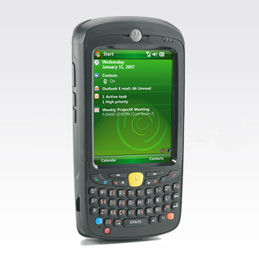Motorola announces new MC55 enterprise digital assistant


There are two new models of MC55 class EDA, the MC5590 with WiFi and Bluetooth that is primarily for workers in an indoor environment with WiFi connection and the MC5574 that adds WWAN so that workers with cellular data connections in the field can stay in touch.
Specifications of the MC55 units include:
- Intel PXA270 520MHz processor
- 128MB RAM and 256MB flash ROM
- 3.5 inch 320x240 touchscreen display
- Windows Mobile 6.1 operating system (Classic or Professional)
- VoIP-enabled
- Ability to survive a 4 foot drop to concrete
- Multi-mode data capture with bar code scanner and 2 megapixel auto focus color camera
- microSD card slot
- Full QWERTY keyboard, with options for other variants
- 11.1 ounces with 2400 mAh battery
The MC5590 EDA is available worldwide through Motorola PartnerSelect members and Motorola sales. The MC5574 is available today in EMEA, Latin America and the Asia Pacific region, and is expected to be available in North America and globally in the second quarter of 2009.